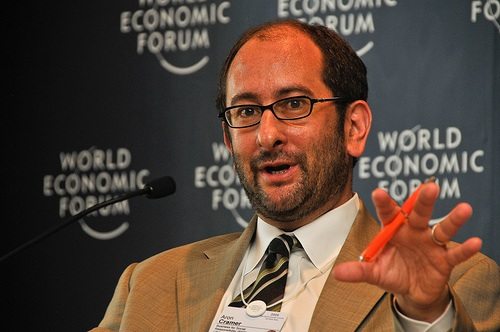
January 22, 2013; Source: World Economic Forum Blog
At Davos, Aron Cramer, the CEO of Business for Social Responsibility, presented the results of a report prepared for the World Economic Forum on the future of civil society. The report provided, as Cramer said, “important insights into the direction global civil society may take in the years ahead.” While touting positive qualities of civil society organizations, such as their flexibility in acting globally and locally, their ability to act as problem solvers, and their ability to “enable new institutional forms to address an ever-evolving global agenda,” Cramer noted the challenges of civil society organizations. Those challenges include resource constraints, problems of transparency, oppression from government, and disintermediation.
We examined the report to see how a Davos group would define and operationalize a plan for boosting civil society, especially given the overwhelming business focus of the World Economic Forum and its programmatic focus on identifying and promoting social entrepreneurs. Prepared with the assistance of KPMG, The Future Role of Civil Society offers a variety of difficult generalizations about—and visions of—civil society that are defined with inchoate borders and contours. The report does, however, offer up six interesting driving forces that may change civil society in the future:
- What is the level and what are the sources of funding for civil society stakeholders?
- What is the social and political influence of increasing access to technology?
- What is the extent and type of citizen engagement with societal challenges?
- What is the state of global and regional geopolitical stability and global integration of markets?
- What is the effect of environmental degradation and climate change on populations?
- What is the level of trust in governments, businesses and international organizations?
The report goes on to explore these driving forces in the context of four possible scenarios:
Sign up for our free newsletters
Subscribe to NPQ's newsletters to have our top stories delivered directly to your inbox.
By signing up, you agree to our privacy policy and terms of use, and to receive messages from NPQ and our partners.
“Mad Max is a world characterized by international and national conflict, where governments exert strong security controls on both business and society. Levels of funding for societal and development challenges are limited.
Transparently Blurred posits a scenario where economic growth is relatively high …and where the government and private sector are both deeply engaged in tackling societal challenges. Access to data, technology and rigorous monitoring are the hallmarks of a revolution in both economic activity and social development.
Turbulence and Trust Deficits depicts a chaotic world where trust is a scarce commodity. Yet, thanks to the possibilities created by the rise of the networked society, there is a significant latent desire for social engagement by citizens, particularly at the local level.
Privatized World is one where many governments are seen to have failed, inequality is extreme, and corporations play the most important role in society as the main providers of social services.”
Emerging from this framework are several conclusions:
- Technology “will give power to civil society and enable new roles to be played with greater impact.
- “Local organizations and grassroots engagement is an important component of many scenarios.”
- “Populations currently under the age of 30 will be a dominant force in the coming two decades.”
- “Faith and religious culture [will be] a major driver of change in society.”
- “High levels of trust across organizations, sectors and generations will become increasingly important as a precondition for influence and engagement.”
- “Cross-sector engagement, particularly between business and civil society,” will be of importance.
- There is a “need for higher levels of accountability, transparency and measurement.”
- “The value of closer, more constructive links between civil society and policy-making” is clear in these future scenarios.
Not surprisingly for a report generated for the World Economic Forum, given its membership of 1,000 leading global corporations, the emphasis of the report is on the future of civil society and business, underscoring the “important trend and source of opportunity [of] the convergence between businesses that are engaging more closely with communities and other stakeholders to tackle issues outside their organizational boundaries, and [of] socially-focused organizations that are adopting commercial strategies or funding models.” Why does the desired future for civil society always end up with a strong dose of for-profit business ethos?—Rick Cohen













